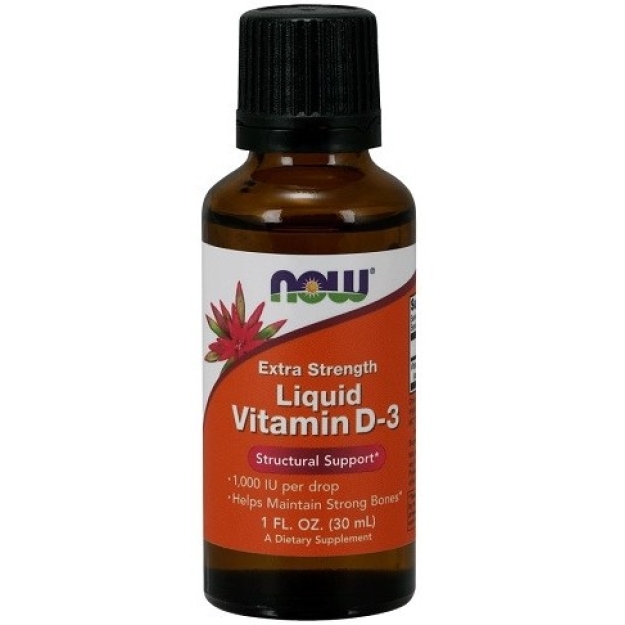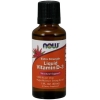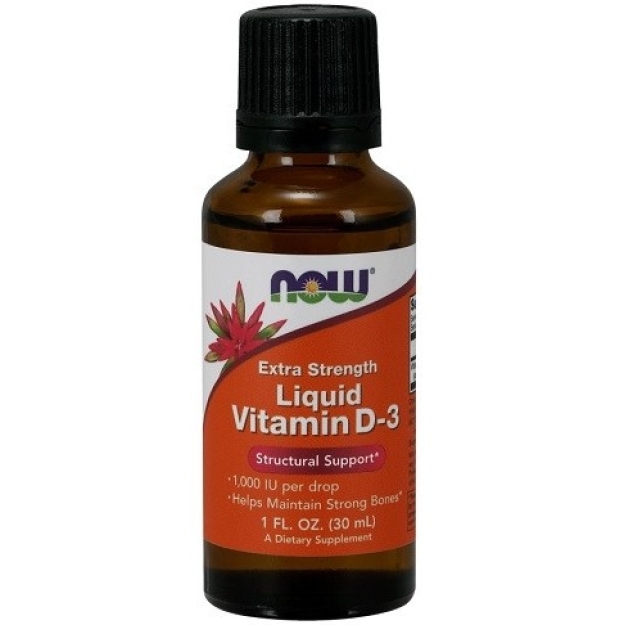Now Foods Vitamin D3 Liquid Extra Strength 30 ml
1,000 IU - Per Drop
Vitamin D is involved in calcium homeostasis by acting on the intestines and bones. It performs its active function as a metabolite of calcitriol, formed in the kidneys under the influence of parathyroid hormone. In the intestine, vitamin D regulates the absorption of calcium and phosphate. In bones, it is of particular importance for the mineralization of newly formed tissue. Vitamin D is also important for the regulation of bone metabolism, which is the basis of its effect in osteoporosis. It is also involved in cell growth and differentiation, because vitamin D receptors have been found in many mammalian cells, including tumor cells.
Today, two vitamins are called vitamin D - D2 (ergocalciferol) and D3 (cholecalciferol) - these are colorless and odorless crystals that are resistant to high temperatures. These vitamins are fat-soluble, i.e. soluble in fats and organic compounds and insoluble in water.
Cholecalciferol is formed in the skin when exposed to ultraviolet rays from sunlight. Provided that the body receives a sufficient amount of ultraviolet radiation, the need for vitamin D is fully compensated. However, the amount of vitamin D synthesized by sunlight depends on factors such as:
1. Wavelength of light (the most effective is the average wavelength spectrum that we receive in the morning and at sunset);
2. Initial pigmentation of the skin (the darker the skin, the less vitamin D is produced by sunlight);
3. Age (aging skin loses its ability to synthesize vitamin D);
4. The level of air pollution (industrial emissions and dust do not transmit the spectrum of ultraviolet rays, potentiating the synthesis of vitamin D).
Functional actions:
- Participates in the regulation of calcium-phosphorus metabolism.
- Enhances the absorption of Ca2 + and phosphates in the intestine (by increasing the permeability of the cellular and mitochondrial membranes of the intestinal epithelium) and their reabsorption in the renal tubules of the kidneys.
- Promotes the mineralization of bones, the formation of the skeleton and teeth in children, is necessary for the normal functioning of the parathyroid glands.
- In the absence of vitamin D, normal calcification does not occur. The epiphyses enlarge, bones soften, and tetany may develop as a result of a lack of ionized calcium in the plasma.
- The concentration of ionized calcium in the blood regulates the secretion of parathyroid hormone. Low calcium levels cause an increase in parathyroid hormone and, therefore, increase the production of 1,25-dihydroxyvitamin D3. This increases the absorption of calcium and phosphorus in the intestines. Parathyroid hormone acts on the bone, increasing the rate of resorption of calcium and phosphorus, especially in old areas where osteoblasts and osteocytes are activated, and collagen synthesis is inhibited. In the kidneys, parathyroid hormone increases the reabsorption of calcium in the tubules and increases the excretion of inorganic phosphate by the kidneys in all parts of the tubules.
Indications for use:
- Hypo- and vitamin D deficiency (prevention and treatment).
- Conditions of increased body demand for vitamin D: rickets, osteomalacia, osteoporosis, nephrogenic osteopathy, inadequate and unbalanced nutrition (including parenteral, vegetarian diet), maltabsorption syndrome, insufficient insolation, hypocalcemia, hypophosphatemia (including familial ), alcoholism, liver failure, cirrhosis, obstructive jaundice, gastrointestinal diseases (gluteal enteropathy, persistent diarrhea, Crohn's disease), rapid weight loss, pregnancy (especially with nicotine and drug addiction, multiple pregnancy), lactation period.
- Newborns who are breastfed with insufficient insolation.
- Taking barbiturates, cholestyramine, colestipol, mineral oils, anticonvulsants (including phenytoin and primidone).
- Hypoparathyroidism: postoperative, idiopathic, tetany (postoperative and idiopathic), pseudohypoparathyroidism.
- Reduced immunity.
Vitamin D is fat-soluble and therefore accumulates in the body, so serious problems can arise if you overdose.
Since vitamin D increases blood calcium levels, excess intake can lead to excess calcium concentrations. In this case, calcium can penetrate into the walls of blood vessels and provoke the formation of atherosclerotic plaques. This process can be accelerated by a deficiency in the body of magnesium.
Vitamin D preparations are contraindicated in diseases such as:
- hypercalcemia, pulmonary tuberculosis (active forms), gastric ulcer and duodenal ulcer,
- acute and chronic diseases of the liver and kidneys, organic heart damage. It is not recommended to take vitamin D without calcium.
Interaction:
- When taking drugs that lower cholesterol levels, you need to take into account that they can interfere with the absorption of fats and fat-soluble vitamins, therefore, vitamin D should be taken at different times with antihyperlipidemic agents.
- Taking mineral laxatives interferes with the absorption of vitamin D, and synthetic laxatives can interfere with the metabolism of vitamin D and calcium.
- Corticosteroid hormones promote the excretion of vitamin D from the body, and also disrupt the absorption and exchange of calcium.
- Some anti-TB drugs (para-aminosalicylate) can alter vitamin D metabolism and disrupt the balance of calcium and phosphorus.
- Antacids and steroid hormones (cortisone) also affect the absorption of vitamin D.
- Taking vitamin D in large doses can lead to iron deficiency. This is because vitamin D stimulates the absorption of calcium in the intestines, and calcium competes with iron for absorption.
Normal metabolism of vitamin D in the liver (where the previous forms are activated) is not possible with a lack of vitamin E.
Storage conditions: at t ° no higher than 25 ° C, out of the reach of children.


























